Physical Address
304 North Cardinal St.
Dorchester Center, MA 02124
This chapter focuses on the most common external eye conditions in children, which are summarized in Fig. 15.1 .
Blepharitis is a disorder of the lid margins that can be associated with ocular surface inflammation. Lid disease can involve the anterior lid margin (lash follicles) or posterior lid margin (meibomian glands). Corneal disease, termed blepharokeratoconjunctivitis (BKC), can occur with both. The clinical features include:
styes and meibomian cysts;
conjunctivitis, phlyctenulosis and episcleritis;
keratitis with vascularization, thinning, and scar;
dermatologic disease.
In children, dermatologic associations (facial rosacea and acne vulgaris) are less common than in adults and may be mild or absent. However, these are sometimes evident in a parent accompanying the child. Corneal disease can progress to significant vision loss with minimal signs of ocular surface inflammation ( Table 15.1 ). In industrialized countries it is second only to allergy as a cause for ocular surface disease in children.
| Associated skin disease (absent in 50% of cases) | Symptoms a | Signs b | ||
|---|---|---|---|---|
| Lids c | Conjunctiva c | Cornea | ||
|
|
|
|
|
a Some patients may be asymptomatic until visual loss is detected.
b Signs may be very asymmetric or even unilateral.
c Lid and conjunctival change can be minimal even with corneal disease.
BKC is thought to be a delayed hypersensitivity response to bacterial antigens and lipases released into the tear film. Colonization of the lid margins by Staphylococcus aureus or Propionibacterium acnes has been implicated but a proposed role for the commensal mite Demodex folliculorum is unproven. Breakdown products of meibomian gland lipid may also cause inflammation and an unstable tear film then amplifies the effect through surface drying. Histologically, there is keratinization of the ductules of the meibomian glands and meibomian gland “drop out” can be demonstrated with infrared imaging. The prevalence is thought to be higher in females and in South and East Asian than White populations.
The age of onset of BKC is bimodal with a peak at 5–7 years and a second peak at adolescence. However, onset can be in the first months of life. There is often a delay of months or years between the onset of symptoms and diagnosis. The symptoms of early cases of BKC are photophobia, epiphora, eye rubbing with chronically red eyes ( Fig. 15.2 ). The disease can be very asymmetric or unilateral (see Table 15.1 ). There may be crusting in the morning, but discharge is not a major feature. Unfortunately, some children are relatively asymptomatic until reduced vision or a corneal opacity alerts the patient or carer.
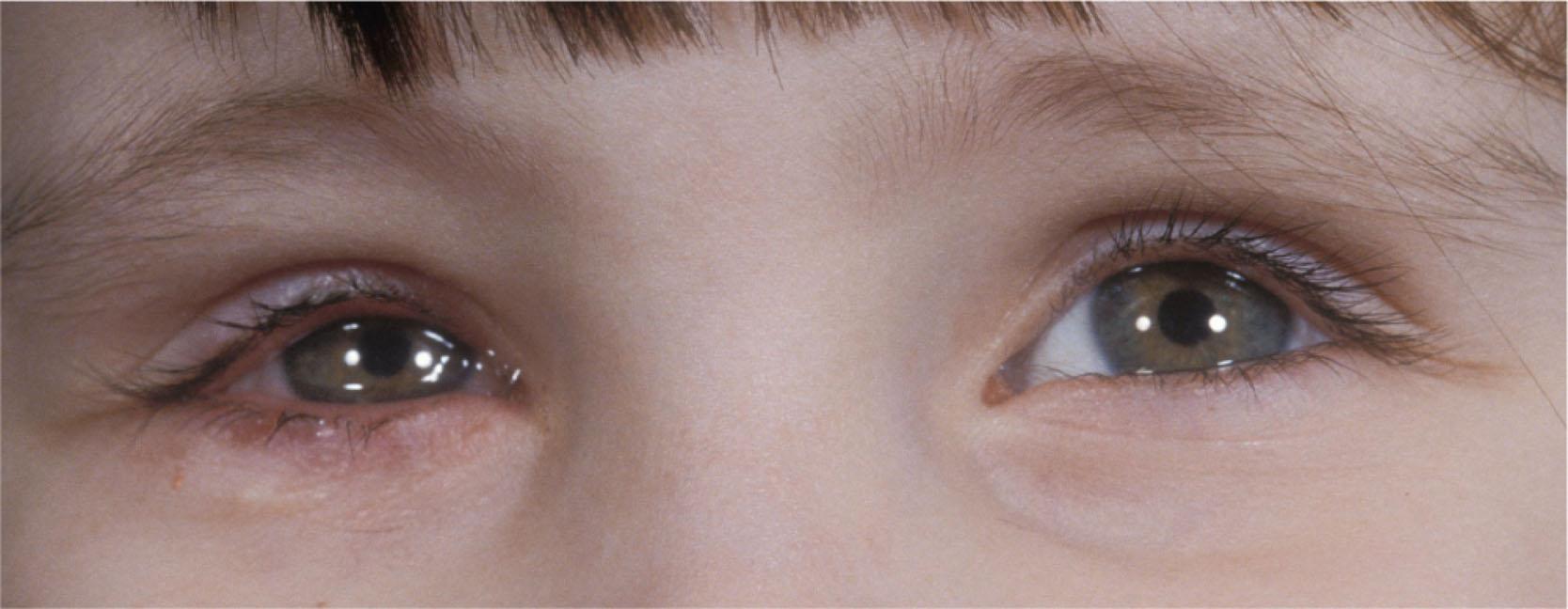
Approximately half of patients with BKC do not have facial skin changes, but a papular rash on the cheeks or acne can develop. Lid signs of anterior blepharitis include scales and collarettes at the bases of the lashes ( Fig. 15.3 ). The appearance of the posterior lid margin can be surprisingly normal, or the lid margins may be thickened, with redness, telangiectasia, crusting, and inspissation of the meibomian gland openings with expression of white sebum with gentle lid pressure. In more active disease, there is a mixed papillary and follicular change, especially in the upper and lower tarsal conjunctiva ( Fig. 15.4 ), with limbitis and conjunctival or corneal phlyctenules ( Figs. 15.5 and 15.6 ). A phlyctenule (or phlycten) is a small white collection of polymorphs and leukocytes with an overlying epithelial defect. Subconjunctival lipid crystals are not always present but are a specific sign for this condition ( Fig. 15.7 ). The corneal epithelial signs range from a reversible mild inferior punctate keratopathy to diffuse corneal stain with fluorescein. More severe corneal changes include irregular astigmatism, sectorial vascularization at the site of previous phlyctenules, corneal thinning or perforation ( Figs. 15.8 and 15.9 ). Vision loss may be insidious and severe.
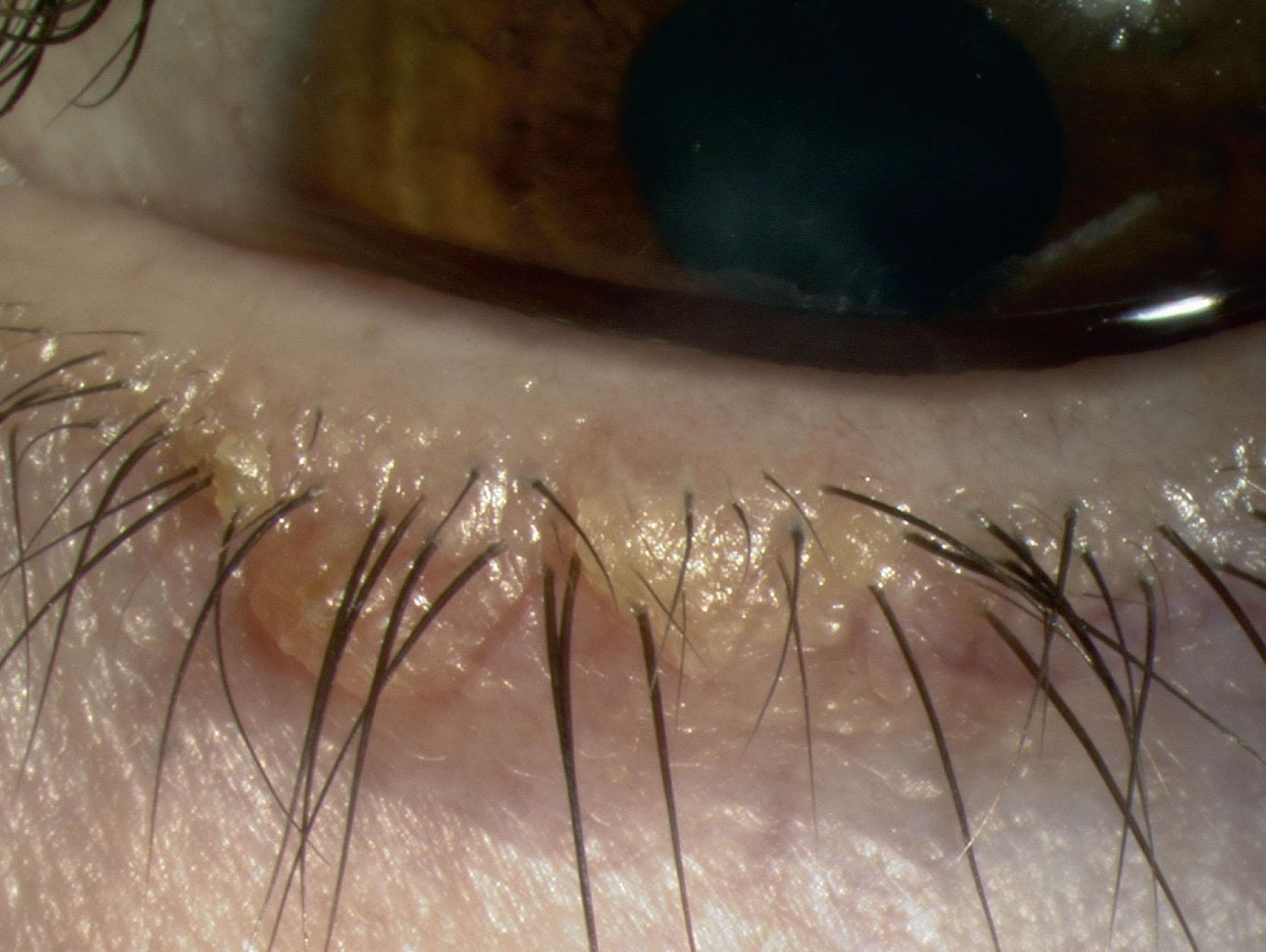
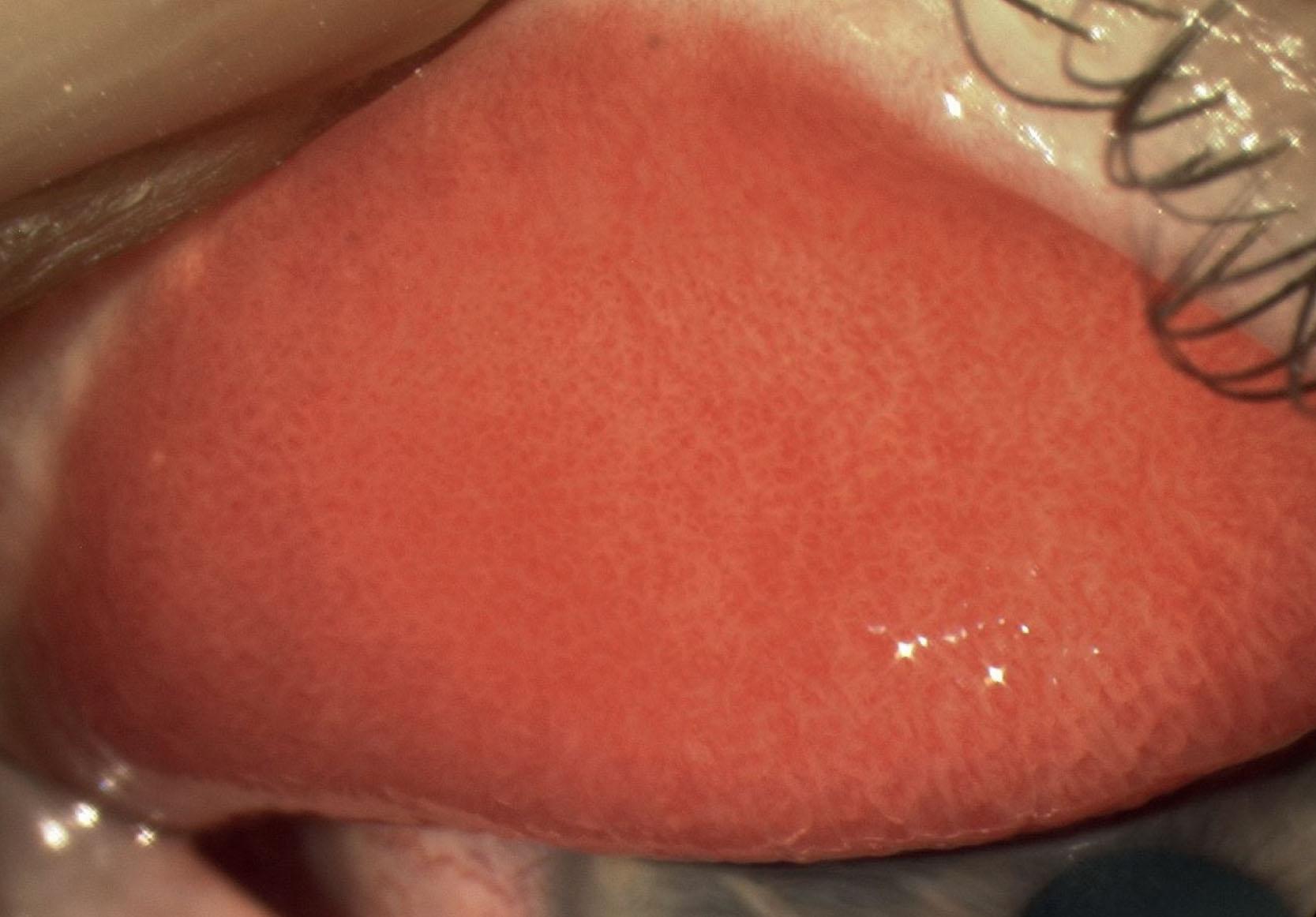
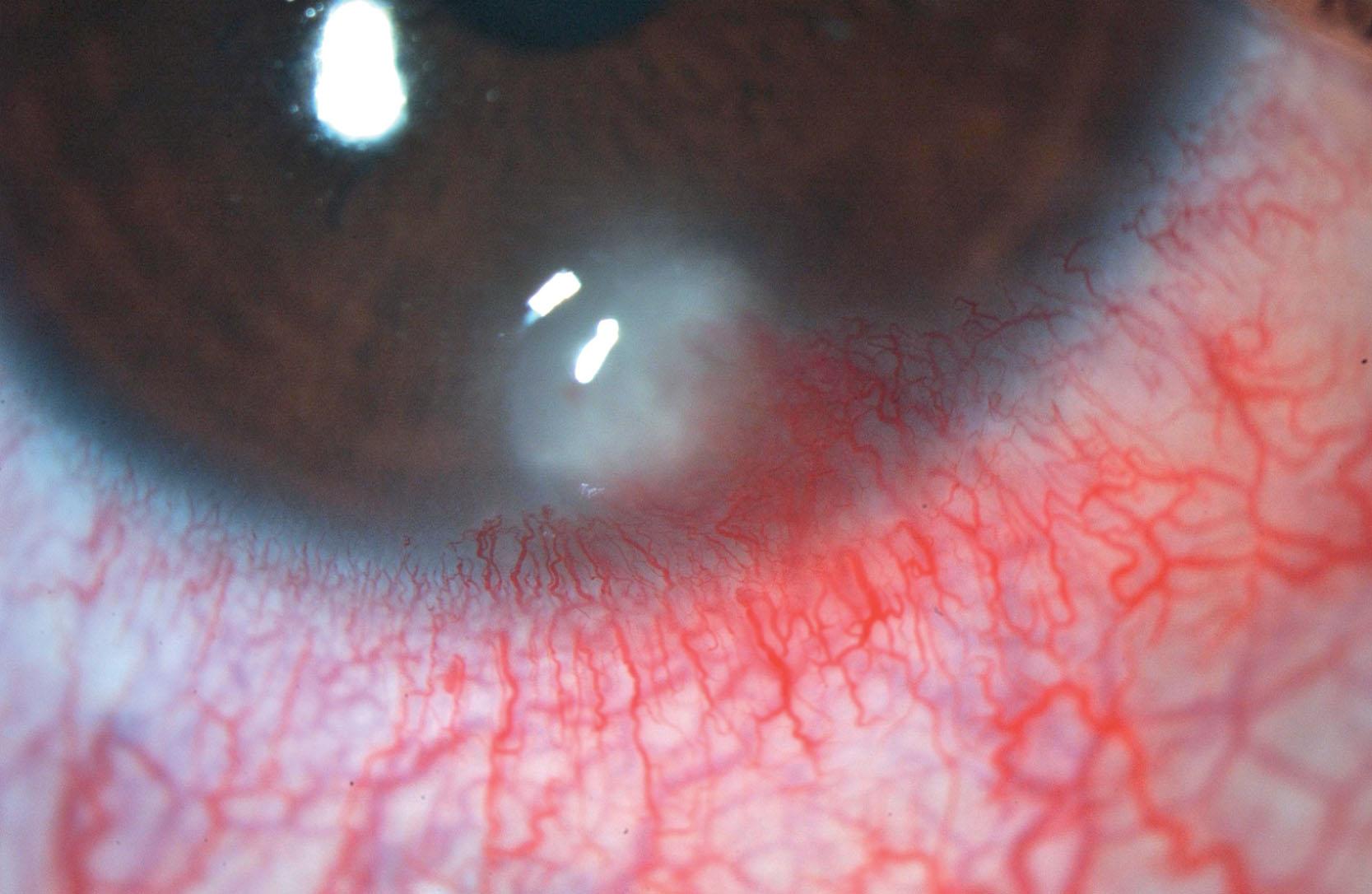
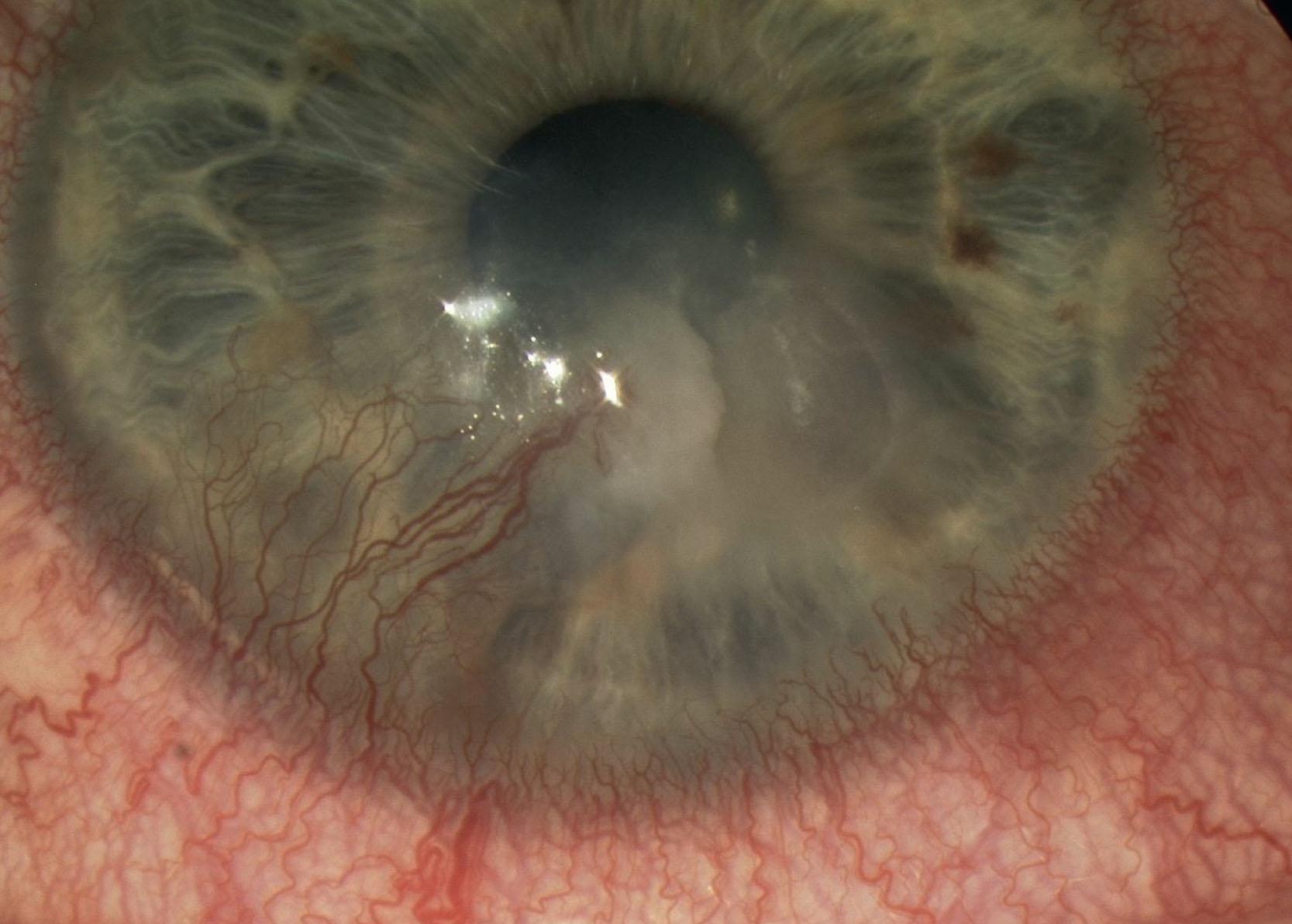
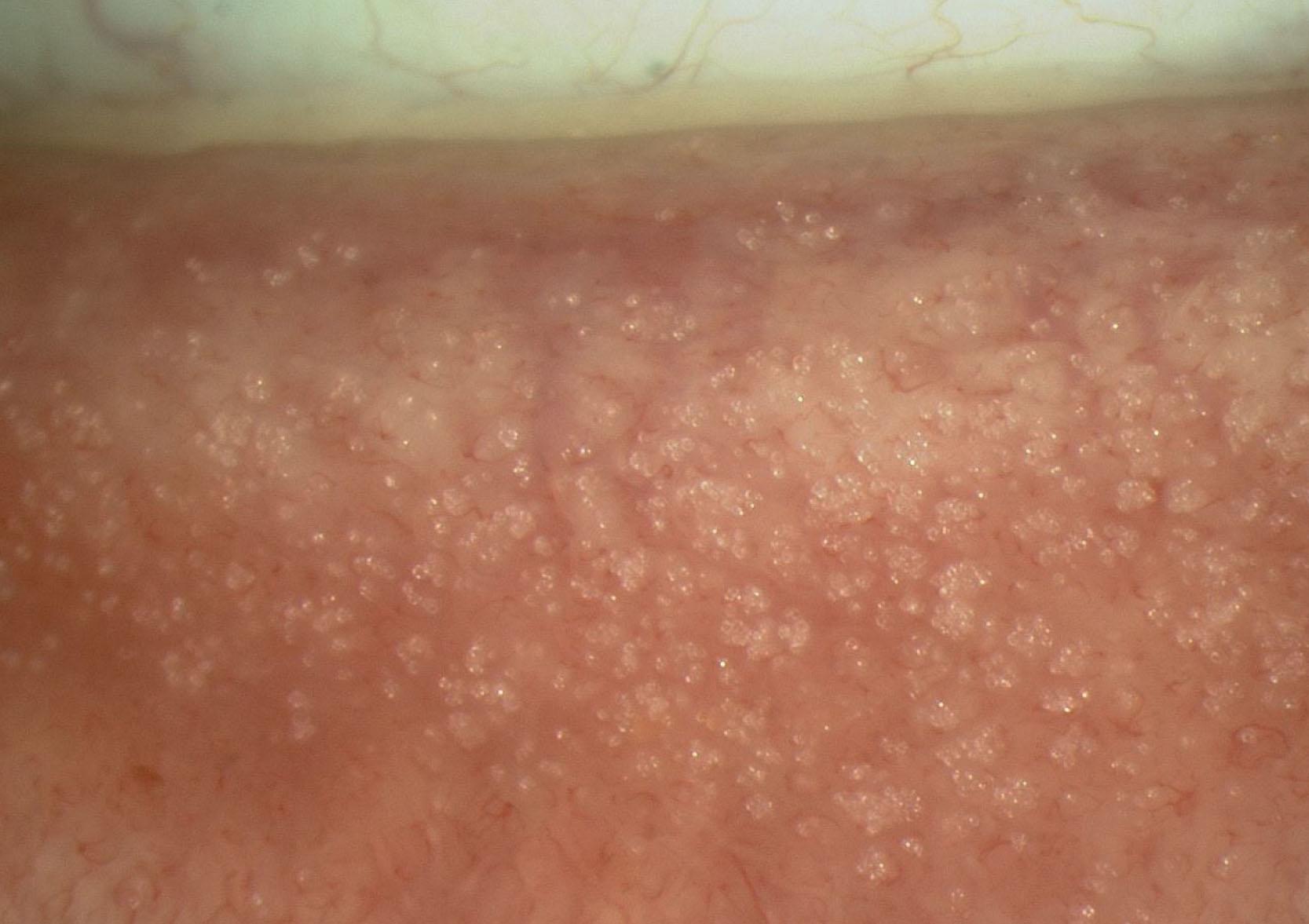
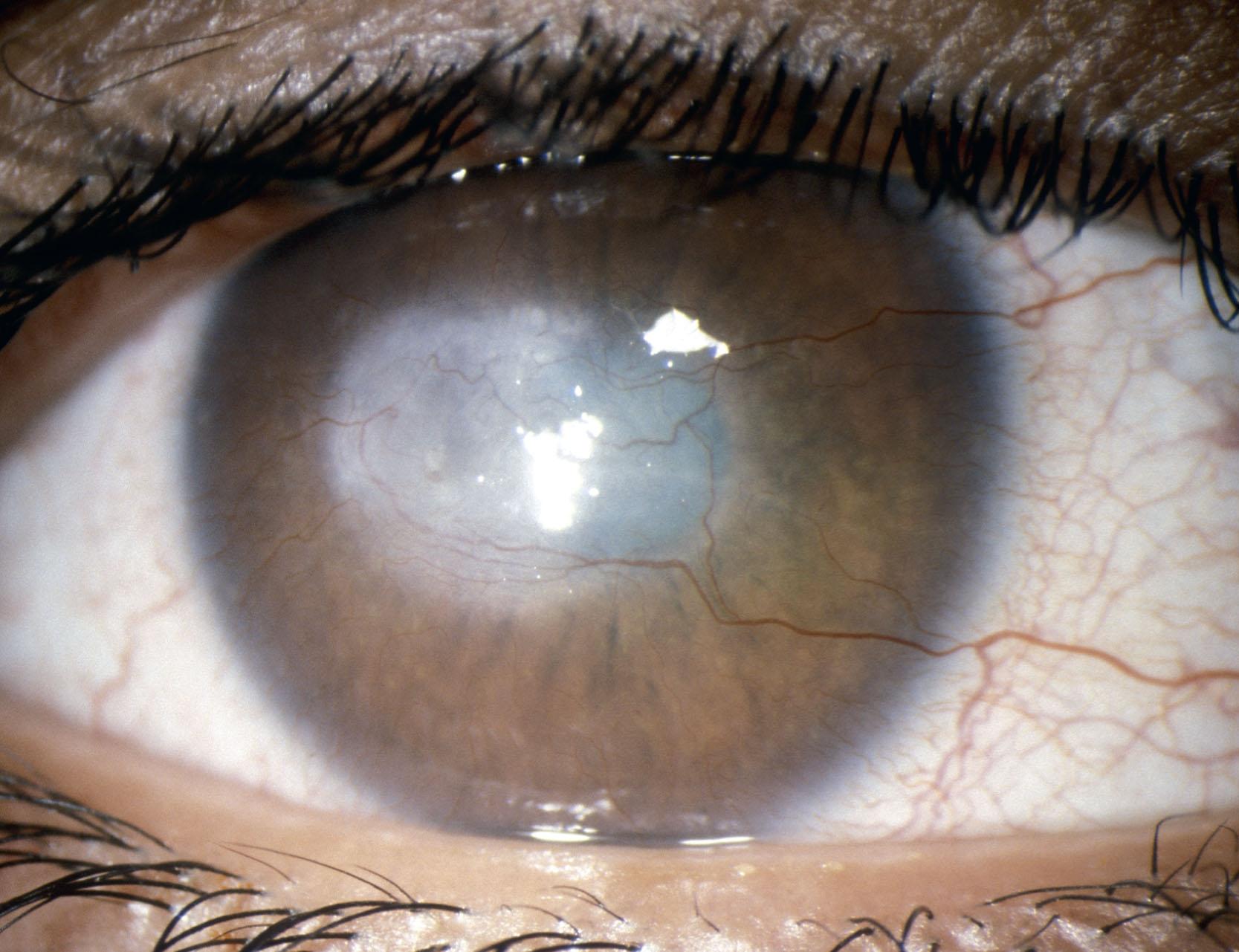
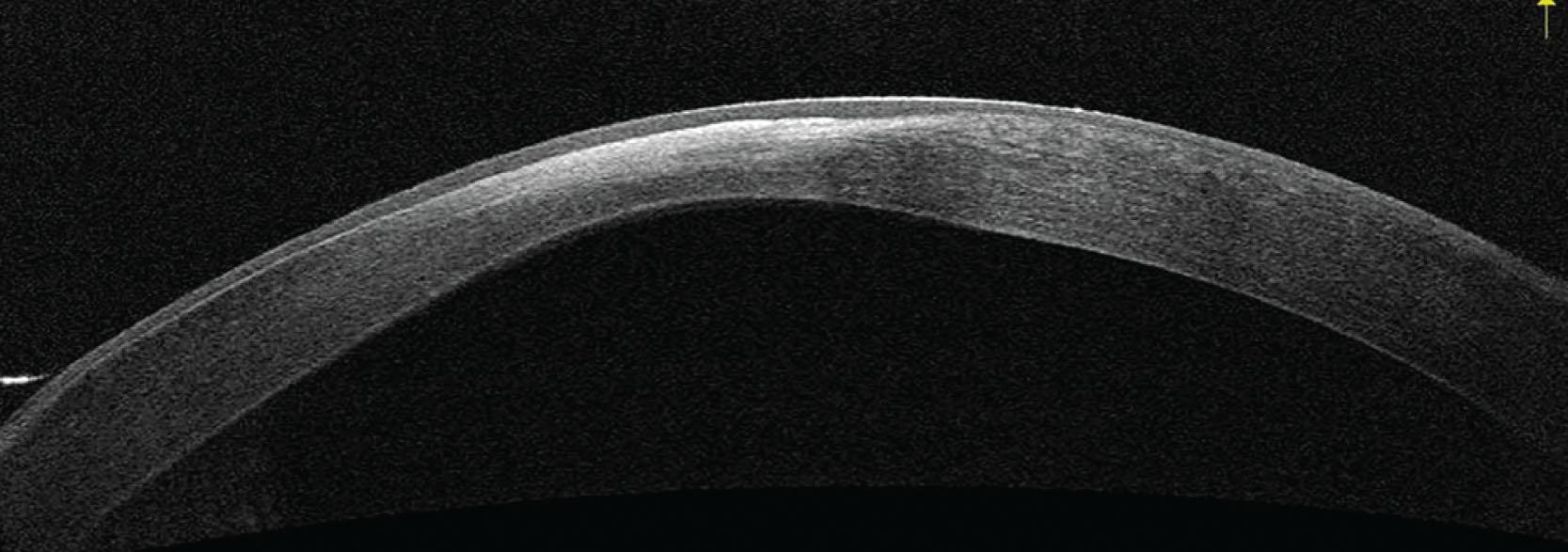
There is unfortunately no high-quality evidence to guide therapy. A hierarchical treatment strategy has been suggested. Options include the following:
Treat acute infection or styes with a warm compress and a short course of topical antibiotic ( Table 15.2 ).
| Option | Agent | Protocol |
|---|---|---|
| 1. Lid scrubs | Daily | |
| 2. Topical antibiotic |
|
Nocte |
| Oc azithromycin 1.5% | bd | |
| Oc metronidazole 0.75% | Skin of face | |
| 3. Oral antibiotic | Erythromicin (<8 years) a | For 3 months b |
| Doxycycline c (>8 years) a | For 3 months b | |
| Azithromycin a | For 5 days b | |
| 4. Topical anti-inflammatory | e.g. Fluoromethalone 0.1% or cyclosporin 1% | As required |
| 5. Immunosuppression d | Supervision by pediatrician | |
| 6. Non-medical management | Fine-needle diathermy | For progressive vascularization |
| Corneal glue | For perforation | |
| Lamellar keratoplasty | For perforation or scar | |
| Rigid contact lens | For irregular astigmatism |
a Dose depends on age and weight.
b Check dose and duration with local guidelines.
c Doxycycline should not be used in children under 8 years and avoided, if possible, in children <12 years. Patients should be warned about skin sensitivity to sunlight and gastrointestinal side effects.
d Immunosuppression is reserved for sight-threatening and uncontrolled inflammation.
Meibomian cysts tend to resolve spontaneously, but they should be incised if they do not resolve after 3 months or if they affect vision by inducing astigmatism or altering lid position. A course of oral antibiotic (e.g. erythromycin, doxycycline, or azithromycin) should be considered if there are recurrent cysts. Note, doxycycline is contraindicated under the age of 8 years.
For chronic disease, a daily warm compress with lid cleaning followed by application of a topical antibiotic (e.g. chloramphenicol, erythromycin, azithromycin) or antiseptic (hypochlorous acid spray). This can take 4–6 weeks to work and long-term maintenance therapy may be required. Long-term low-dose (sub-antimicrobial) oral tetracycline or macrolide antibiotic, e.g. erythromycin, azithromycin, or doxycycline, are thought to work through an anti-inflammatory effect. Lid scrubs with chlorhexidine 0.02% may help if there is severe lid margin inflammation.
Topical immunosuppression with corticosteroid is an option if there are phlyctenules or significant corneal disease. Initially four times a day, reducing to once daily or less after 4 weeks. Long-term treatment (i.e. for years) with low-dose steroid with poor intraocular penetration (fluoromethalone 0.1%) may be required. Intraocular pressure should be monitored even with very low-dose therapy. A short course of intensive treatment (e.g. prednisolone 1% hourly) may be required to control intense inflammation. The off-license use of topical cyclosporine 1% or tacrolimus is an alternative to topical corticosteroid.
Topical metronidazole gel can help facial skin disease.
The effect of manual expression of the meibomian gland secretions or duct probing is debated and it is difficult to perform without sedation in young children.
Rarely, for inexorable corneal opacification, or if corneal surgery is planned, systemic immunosuppression (e.g. oral corticosteroid, mycophenolate, or azathioprin) is required.
Secondary microbial keratitis should be investigated and treated immediately.
An axial corneal opacity or irregular astigmatism may cause amblyopia. Visual correction may be possible in older children using a rigid contact lens.
Corneal perforation should be managed immediately with application of cyanoacrylate glue or lamellar keratoplasty.
Many cases of BKC require very prolonged treatment and even with all these options an estimated 10% of cases do not respond.
The great majority of cases of phlyctenular disease in industrialized countries are associated with staphylococcal lid margin disease, but phlyctenules are a reported association with tuberculosis, and very rarely with helminthiasis, leishmaniasis, and candidiasis. In areas where tuberculosis is endemic, a child with a phlyctenule should be screened for tuberculosis.
Lesions of discoid lupus erythematosus at the lash margin can mimic chronic blepharitis. These may respond to topical treatment with corticosteroid but systemic therapy (e.g. hydroxychloroquine) is usually required. Lash or eyebrow infestation by crab lice ( Phthirus pubis ) can cause low-grade irritation and conjunctivitis ( Fig. 15.10 ). Manual removal of the eggs (nits) and lice at the slit-lamp, followed by application of white soft paraffin eye ointment to the lid margin twice daily for 10 days to smother the lice and eggs, is effective. Insecticides (e.g. permethrin 5%, malathion 1%) are not licensed for ocular use; they are used in shampoos or creams, but they cause ocular irritation. Decontamination of bed wear is essential. Because of the possibility of child abuse, a pediatrician should be involved and screening for sexually transmitted infections such as chlamydia may also be indicated.
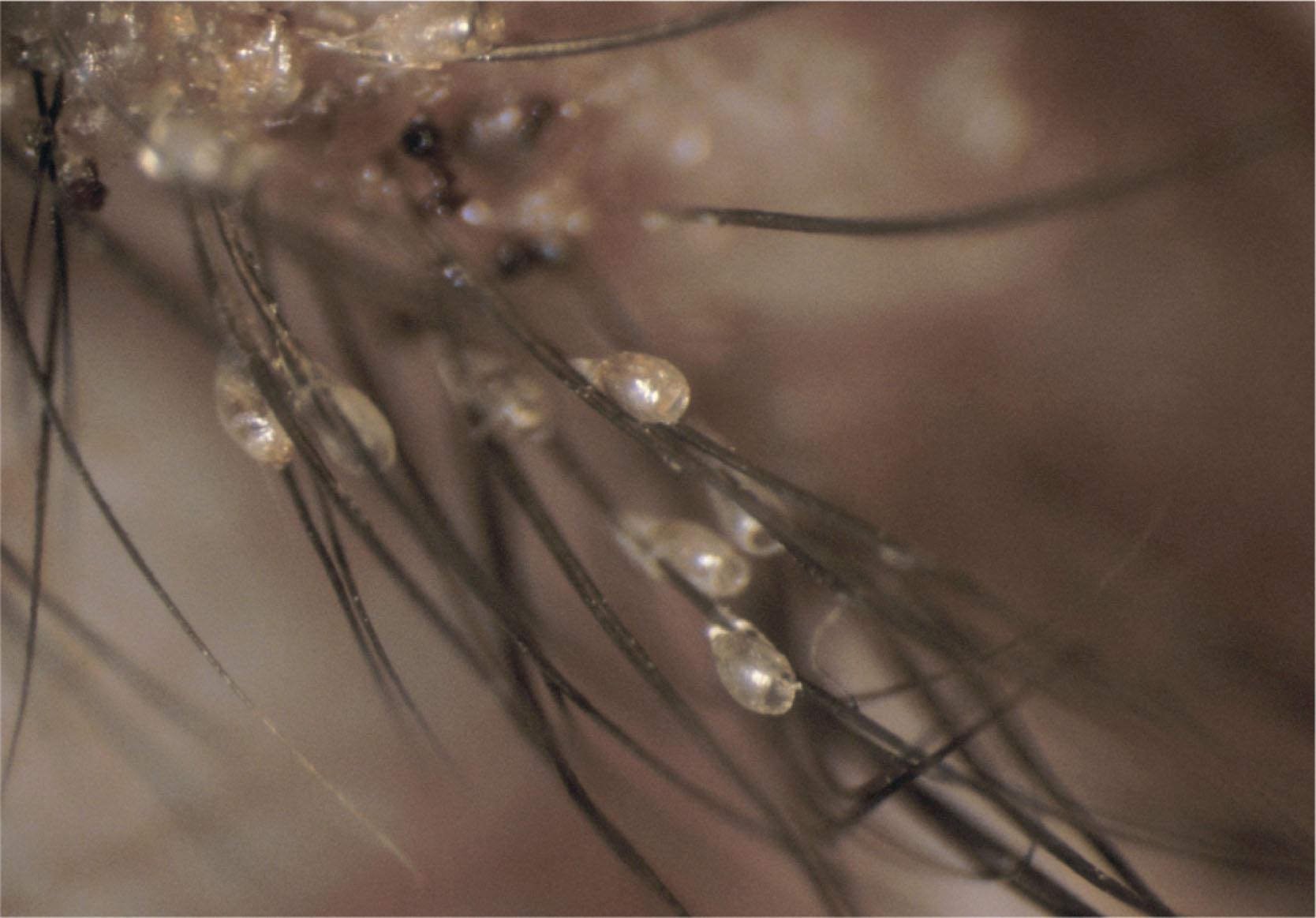
The causes of conjunctivitis are outlined in Fig. 15.1 .
Acute bacterial conjunctivitis is common in young children. Bilateral glued lids on waking is very suggestive of bacterial infection. About 70% of cases are bilateral with a mucopurulent discharge, diffuse bulbar redness, and papillary hypertrophy of the upper tarsal plate conjunctiva. Haemophilus influenzae , Streptococcus pneumoniae , Moraxella catarrhalis , and Staphylococcus aureus are the most common pathogens. Keratitis is uncommon in acute blepharitis. One-quarter of children with conjunctivitis have a symptomatic otitis media, which usually resolves spontaneously. Viruses (adenovirus, picornavirus, herpes simplex virus [HSV]) are isolated in 6% of community-acquired cases, and preauricular adenopathy is a characteristic feature of viral infection. BKC, allergic conjunctivitis, and contact dermatitis should be considered as alternative causes.
Acute infective conjunctivitis is typically self-limiting and resolves spontaneously (65% in 2–5 days) ( Fig. 15.11 ). Complications of untreated disease are unusual. Initial management is irrigation with cool boiled water with removal of secretions on the lids with a moist cotton pad. The use of an antibiotic is unnecessary for most cases, although if used within 5 days of onset, they accelerate the resolution of symptoms and bacterial clearance. There is no evidence to support the superiority of any particular antibiotic. Topical povidone-iodine may be an alternative treatment if a topical antibiotic is not available. It is not necessary to keep children away from school unless an adenoviral infection is suspected.
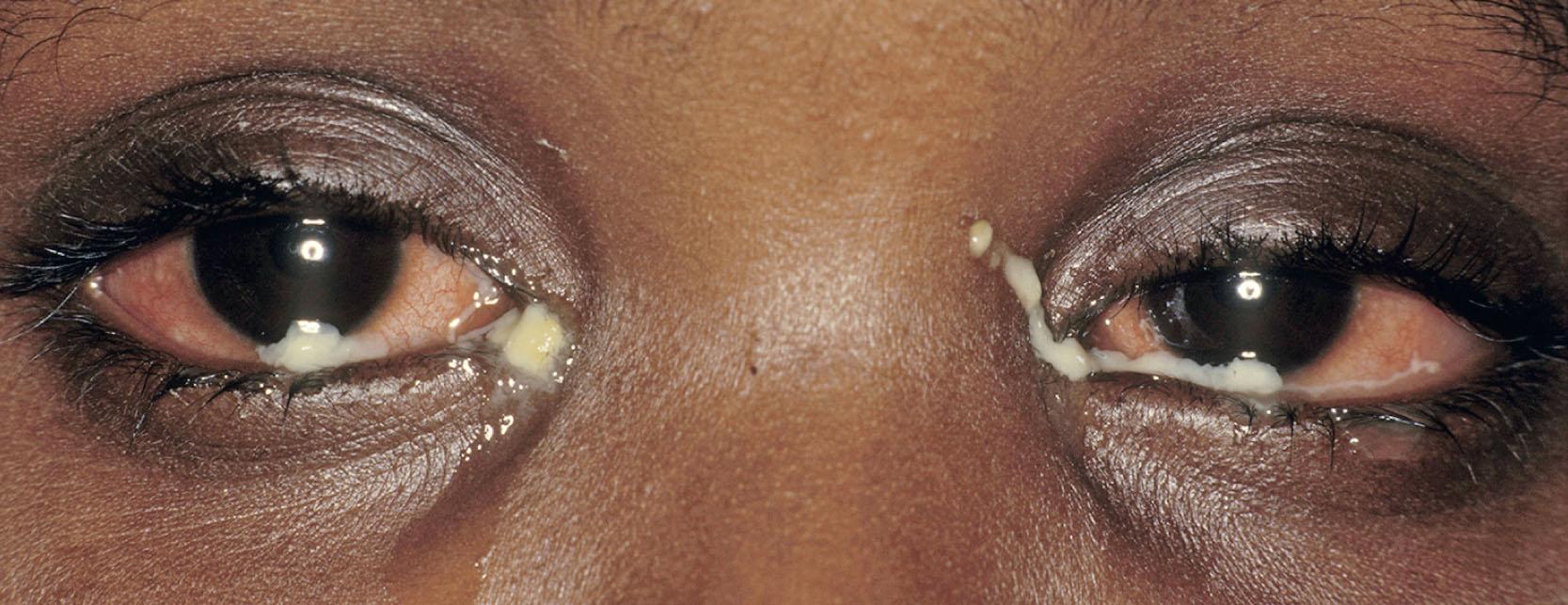
Hyperpurulent conjunctivitis requires urgent attention: it may be associated with severe corneal and systemic disease. Patients are typically febrile with a rapid onset of periocular swelling, mucopurulent discharge, pain, hemorrhagic conjunctivitis, and chemosis. Lid swelling and photophobia may make examination difficult. It is important to exclude infection with Neisseria gonorrhoeae and N. meningitidis , although Staphylococcus , Streptococcus , Haemophilus , and Pseudomonas spp. may rarely cause a similar picture ( Figs. 15.12 and 15.13 ). Neisseria gonorrhoeae conjunctivitis is not always sexually acquired, although this possibility should be excluded, and infection has resulted from the use of traditional medicines. Neisseria gonorrhoeae causes a rapidly progressive ulcerative keratitis with a characteristic superior corneal gutter that can rapidly perforate. Neisseria meningitidis conjunctivitis is usually acquired by airborne spread within schools or colleges. Although less severe, in 15% it causes epithelial breakdown and ulcerative keratitis. Metastatic spread of N. meningitidis to the eye can occur as a terminal event following septicemia.
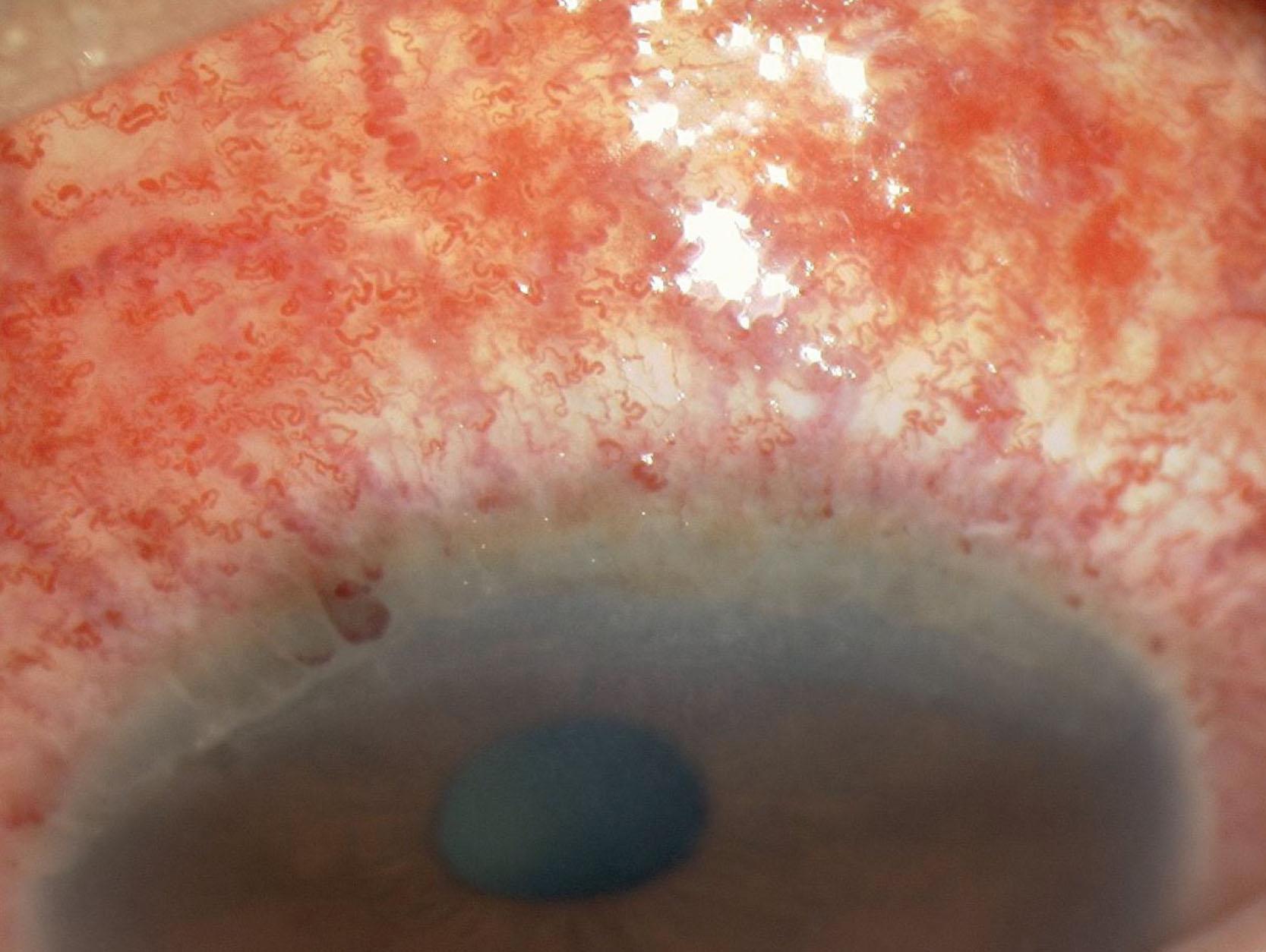
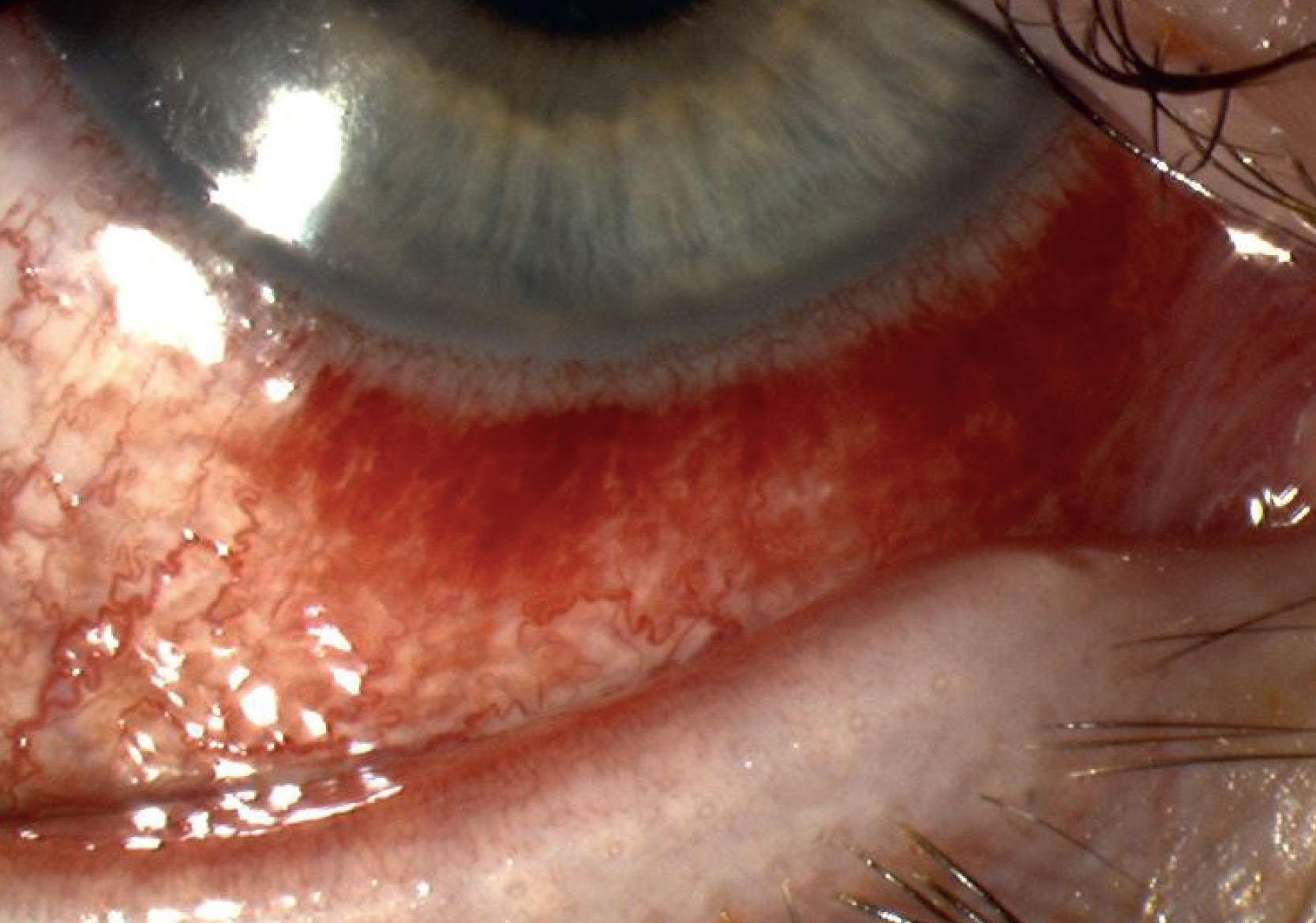
Differentiating membranous and pseudomembranous conjunctivitis is not useful. Any severe conjunctivitis (infectious, chemical, immune) can lead to membrane formation with corneal infiltrates and epithelial sloughing. Resolution may be accompanied by conjunctival scarring with non-progressive symblepharon and secondary entropion or trichiasis. Potential causes include:
adenovirus and HSV
Stevens–Johnson syndrome, toxic epidermal necrolysis, mucoplasma mucositis
Neisseria spp.
Corynebacterium diphtheriae (rare in industrialized countries)
Streptococcus pyogenes , Haemophilus influenzae , Staphylococcus aureus
accidental or non-accidental chemical injury
ligneous conjunctivitis.
Cultures and PCR are not always necessary but should be performed when there is:
associated corneal disease (microbial keratitis)
hyperacute conjunctivitis
chronic conjunctivitis (symptoms >2 weeks)
ophthalmia neonatorum (infection before 28 days) (discussed in Chapter 12 ).
Samples should include an urgent Gram stain and culture on blood agar. Multiplex polymerase chain reaction (PCR) should exclude Neisseria spp., Chlamydia , adenovirus, HSV, and varicella zoster virus (VZV). Treatment guidelines are presented in Table 15.3 .
| Indication + common pathogens | First-line treatment | Alternative |
|---|---|---|
| Acute conjunctivitis a | ||
|
|
|
| Hyperacute bacterial conjunctivitis | ||
|
|
|
| Chlamydia conjunctivitis | ||
| Chlamydia trachomatis b,c |
|
a Acute conjunctivitis has a 65% chance of resolving without treatment within 2–5 days.
b Important: Seek opinion from pediatric genitourinary or infectious diseases specialist.
c Important: Seek referral to pediatrician to exclude child abuse.
Systemic treatment is usually required for patients with hyperpurulent conjunctivitis, or if there is evidence of generalized infection, and for immunosuppressed patients. These patients should be admitted to hospital until the diagnosis and management have been confirmed. Consultation with an infectious disease specialist should be arranged. Patients with otitis media and hyperpurulent conjunctivitis may harbor identical strains of Haemophilus influenzae in both sites and systemic therapy is indicated.
Adenovirus, herpes simplex virus (HSV), and varicella zoster virus (VZV) are the principal causative agents. Coxsackievirus A24 and enterovirus 70 can cause localized epidemics of acute hemorrhagic conjunctivitis.
The adenovirus is a highly stable double-stranded DNA virus. In many parts of the world, adenoviral keratoconjunctivitis is the most common viral infection of the ocular surface, causing community- or clinic-based epidemics. It accounts for approximately 8% of cases seen in primary care and 62% of cases seen in the ophthalmic emergency room. There are more than 50 serotypes but although the ocular clinical signs of the ocular pathogenic strains (serotypes 3, 4, 7, 8, and 19) vary in severity there is overlap. Distinguishing the clinical subtypes (pharyngoconjunctival fever, epidemic keratoconjunctivitis) is of limited value when determining management. Adenovirus can rarely be a cause for chronic relapsing follicular conjunctivitis.
Adenovirus infection causes acute lid swelling, a mixed papillary and follicular conjunctivitis, petechial hemorrhages, conjunctival membranes, and preauricular lymphadenopathy ( Fig. 15.14 ). There may be an upper respiratory tract infection, vomiting and abdominal pain, urethritis, and cervicitis. Corneal epithelial sloughing and anterior uveitis can occur. Usually, a focal epithelial keratitis develops in 3–5 days, followed after 2 weeks by the development of immune-mediated focal subepithelial infiltrates ( Fig. 15.15 ). After 3 weeks, the epithelial changes subside, leaving subepithelial scarring that can result in irregular astigmatism that usually resolves without treatment over 12 months but which may be permanent. Subconjunctival scarring is common but not progressive or clinically significant. Diagnosis in the acute stage can be confirmed by PCR or commercially available enzyme-linked immunosorbent assay (ELISA)-based kits for use in the clinic.
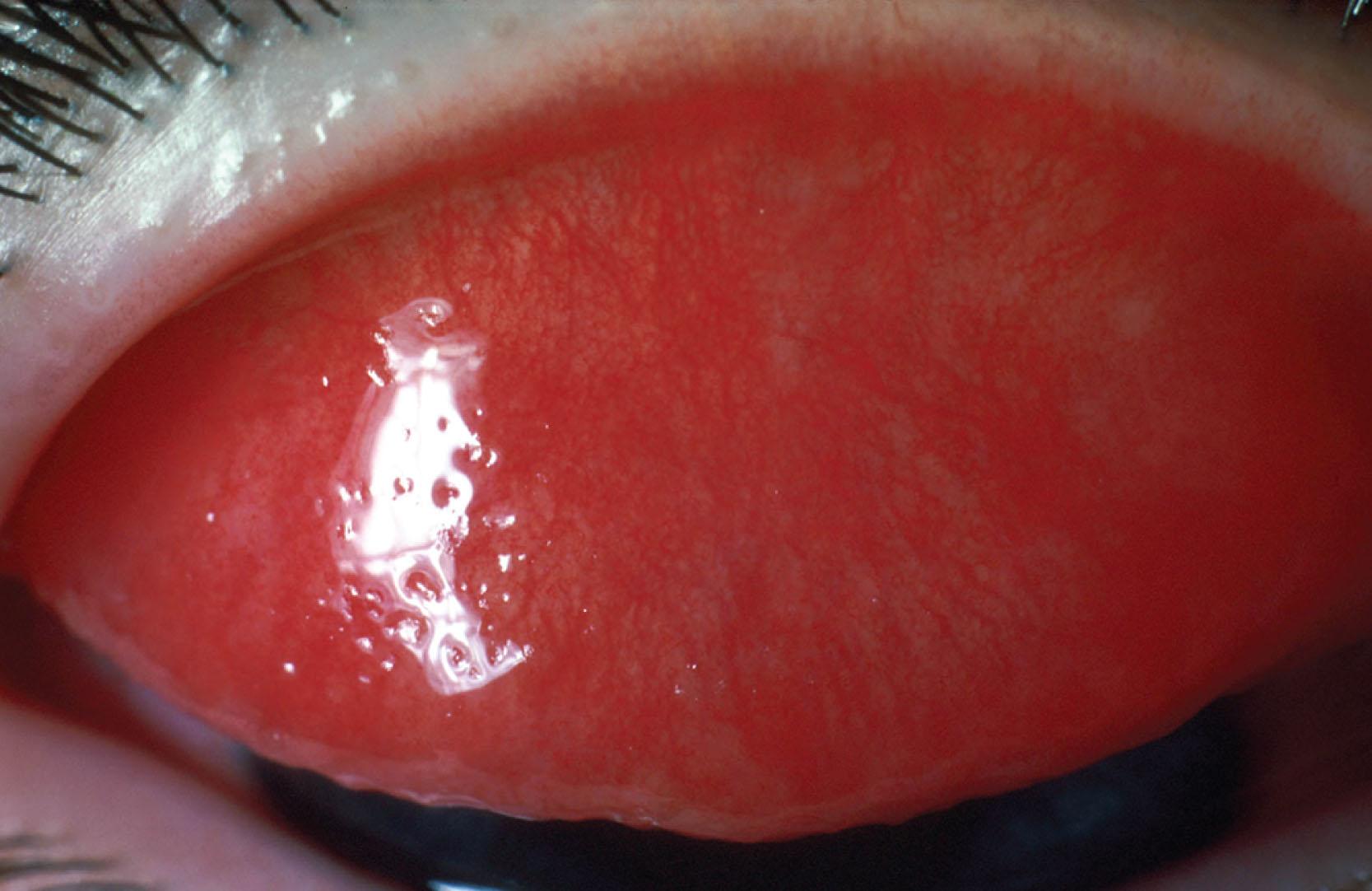
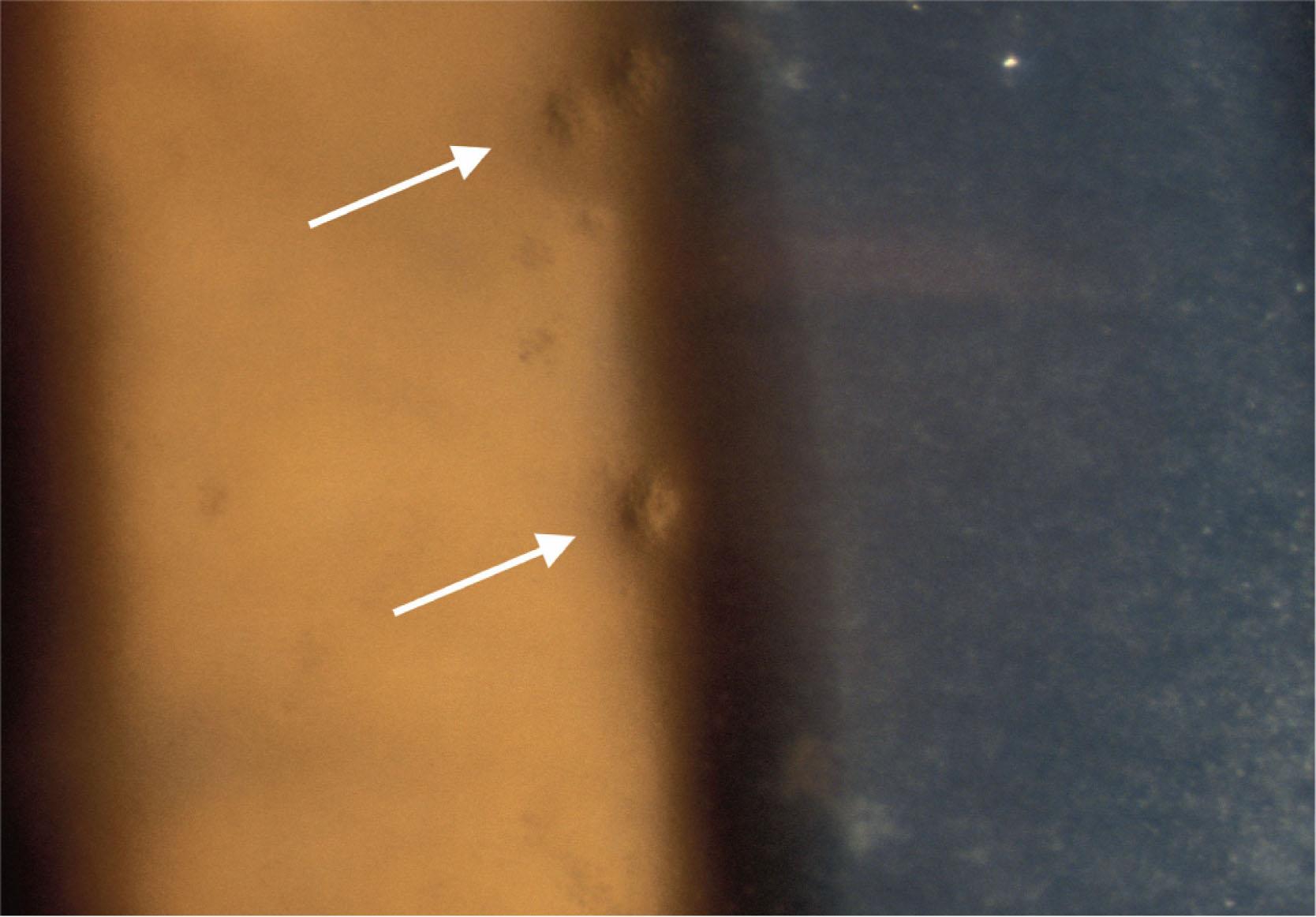
There are no controlled trials showing that topical steroid or antiviral therapy improves the final outcome of adenoviral keratoconjunctivitis. Current treatment is based on symptomatic relief with cold compresses. Removal of conjunctival membranes can improve comfort but not the final outcome. The use of topical corticosteroids is controversial for although they help relieve symptoms they may lengthen the period of virus shedding and patients may be infectious for longer. Corticosteroids should be restricted to cases with visual reduction secondary to acute keratitis or if there is a membranous conjunctivitis or uveitis, and topical corticosteroid is unlikely to precipitate herpetic epithelial disease even if there is HSV conjunctivitis. Tacrolimus or cyclosporin may be alternatives to topical steroids for subepithelial infiltrates. Topical non-steroidal agents, interferon, and antivirals (e.g. ganciclovir, trifluorothymidine) have no effect and should not be used ( Table 15.4 ). Clinical trials of a combination of povidone-iodine and dexamethasone are in progress.
| Common pathogens | First-line treatment a | Alternative |
|---|---|---|
|
|
G triflorothymidine 1% 5 times daily for 7 days |
| Varicella zoster virus (VZV) |
|
|
|
Nil |
a Use prophylactic topical antibiotic in patients with existing ocular surface disease or previous surgery (glaucoma tube, corneal graft, etc.).
b Dose depends on age and weight.
c Systemic treatment required if there are signs of intraocular inflammation. VZV usually treated with higher (double) oral dose compared to HSV.
Because there may be 4–10 days of virus shedding before clinical disease is apparent, and because adenovirus can survive for days on dry surfaces, spread of infection between patients and clinicians is common. The lack of effective treatment has led to strict protocols to limit nosocomial virus spread. Patients with an acute conjunctivitis should be seen promptly in a separate area of the clinic where they cannot mix with other patients; gloves should be worn and equipment should be decontaminated after use.
Neonatal infection with herpes simplex virus (HSV) is a rare (10:100,000 births) but potentially devastating complication of genital herpes during pregnancy. It is associated with considerable morbidity and mortality: untreated, the case-fatality rate is estimated to be 60%. Neonatal herpes conjunctivitis is the result of genital HSV types 1 or 2 shed during delivery, although postpartum infection from caregivers is also possible, and is discussed in Chapter 12 . Diagnosis is confirmed by PCR, which will distinguish HSV types 1 and 2. A rising titer of IgM antibodies is also helpful, although this does not distinguish the HSV type.
In children herpes simplex conjunctivitis or blepharoconjunctivitis ( Fig. 15.16 ) is less common than adenonviral conjunctivitis. It may be the result of a primary infection or recurrent disease following asymptomatic primary infection. It is often unilateral, with a mixed papillary and follicular response, and is associated with preauricular lymphadenopathy. There may be a diffuse punctate keratitis or a dendritic ulcer, with multiple dendrites or geographic lesions in the presence of vernal keratoconjunctivitis. Healing is accelerated by treatment with an antiviral such as ganciclovir ointment or trifluorothymidine drops five times a day for 1 week. Secondary infection of the lid skin vesicles by Staphylococcus aureus in association with atopic dermatitis is called eczema herpeticum. Oral acyclovir and an oral antibiotic (e.g. erythromycin) to treat staphylococcal superinfection are effective for eczema herpeticum.
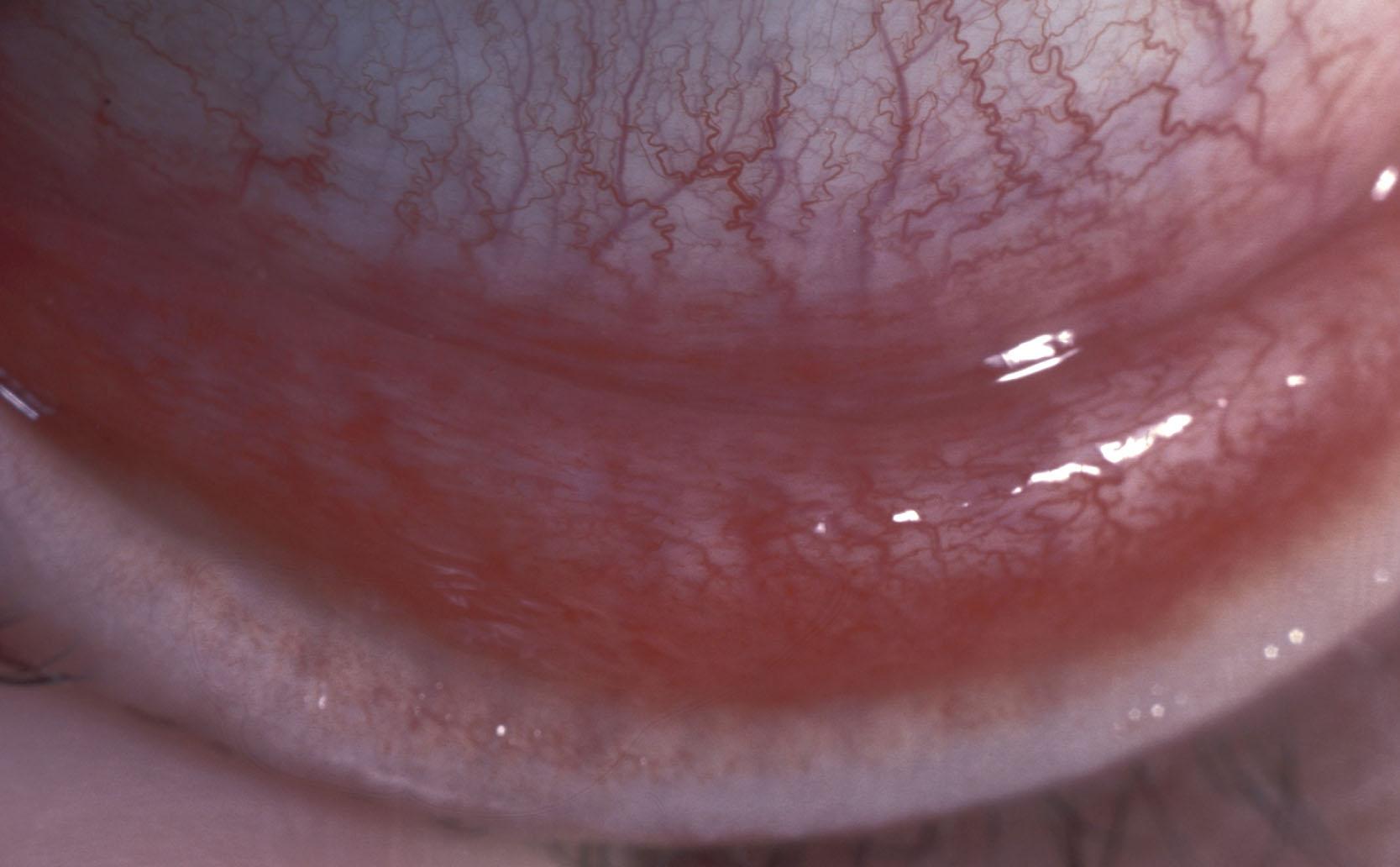
Local epidemics of acute hemorrhagic conjunctivitis caused by enterovirus 70 or coxsackievirus A24 have occurred worldwide since the first description in the 1970s. It has a rapid onset and resolution with characteristic petechial subconjunctival hemorrhages, without permanent corneal change. Direct inoculation or the fecal–oral route are thought to account for the majority of transmission and children in deprived areas are therefore susceptible. Confirmation of infection is by PCR or by the presence of antibodies in serum after infection. There is no effective treatment; management relies on infection control. The outcome is usually benign, although aseptic meningitis or radiculomyelitis have rarely (1:10,000) been reported with enterovirus 70 infection.
Chlamydia trachomatis is a Gram-negative obligate intracellular bacterium that usually infects the genital tract. In children an infection with serotypes D–K is rare and suggestive of child sexual abuse. However, in young children, untreated vertically acquired chlamydia can persist for some years after birth. There is a mixed follicular and papillary conjunctivitis with mucopurulent discharge and preauricular lymphadenopathy. The follicles may be prominent in the lower tarsal and bulbar conjunctiva. Keratitis is infrequent but the superior cornea can show a superficial punctate keratitis followed by subepithelial opacities and peripheral vessels. Diagnosis is by PCR of tear fluid. Local treatment, monitored by a pediatrician, is with topical azithromycin but systemic treatment with a single dose of oral azithromycin or a course of erythromycin or doxycycline are required to eradicate infection. Children should be investigated for other sexually transmitted infections (STI) such as N. gonorrhoeae .
This is an important cause of external eye disease and a leading infectious cause of blindness worldwide. In 2020, an estimated 137 million people in 44 countries live in trachoma endemic areas, and 1.9 million have suffered irreversible visual loss due to trachoma sequelae (1.4% of global blindness), although approximately 40 million are at risk. In highly endemic areas, the prevalence of trachoma in pre-school children can be as high as 90%. It has disappeared from most developed countries. Infection with serotypes A–C of Chlamydia trachomatis can cause conjunctivitis in children that progresses to scarring and blindness as adults. Recurrent inflammation is associated with scarring, but it is not clear whether re-infection is necessary. Transmission is by direct or indirect passage of eye or nasal secretions containing C. trachomatis elementary bodies, by eye-seeking flies, or by aerosol, often in the family setting.
Active disease in children is usually characterized by a mixed follicular and papillary response, best seen over the everted upper tarsal plate, often accompanied by a severe inflammatory response that obscures the underlying vessels over the tarsal plate, and a superior corneal pannus. Over time (rarely in childhood) the tarsal plate scars and the lid margin turns inward to cause trichiasis. Resolved follicles at the superior limbus leave depressions (Herbert's pits) that are pathognomonic of previous infection. Corneal blindness is usually delayed until adulthood and is the result of trichiasis, dry eye, secondary infection, and vascularization. The stages of progression of disease signs are graded in the WHO simplified classification.
Control of the disease is by implementation of the SAFE strategy:
S = S urgery for trichiasis
A = mass distribution of A ntibiotics
F = F acial cleanliness
E = E nvironmental improvement
Treatment of acute conjunctivitis is with a single dose of oral azithromycin (20 mg/kg body weight), or 6 weeks of 1% tetracycline ointment or azithromycin drops. Mass drug administration (MDA) with a single dose or oral azithromycin (or topical azithromycin twice daily for 3 days), reduces the community pool of infection and is recommended when the prevalence of active infection is >5%. There is no vaccine. Clinical signs may persist for months after active infection has been eliminated. If there is trichiasis, lash epilation and lid taping are short-term options prior to lid eversion surgery.
This is usually an association with blepharoconjunctivitis. Apart from Chlamydia trachomatis other rare chlamydial infections include feline pneumonitis, psittacosis, and lymphogranuloma venereum. Chronic canaliculitis and secondary conjunctivitis caused by Actinomyces spp. is rare in children. Hypersensitivity or toxicity to medications, especially preservatives such as benzalkonium chloride, or some glaucoma medications, can produce a follicular response. Other potential causes are described below.
Molluscum contagiosum is a double-stranded DNA poxvirus. It is highly contagious and transmission is by direct contact or autoinoculation to the eye, but with a tendency for spontaneous resolution. Molluscum lesions are umbilicated; when on the lid or close to the lash line they can easily be missed ( Fig. 15.17 ). In this location they can cause a chronic follicular conjunctivitis, usually unilateral with a peak incidence at ages 2–4 years. Widespread facial lesions can develop in patients with atopy, in the immunosuppressed, and they can be a marker for severe HIV/AIDS. Treatment is by physical removal with expression or curettage of the core of the lesion, facilitated by making a small incision in the inner margin of the lesion with the tip of a needle – cautery or cryotherapy is unnecessary since it may cause depigmentation of the lid margin and loss of lashes; resolution is then rapid after curettage and topical steroid is not required. The histopathology is characteristic: a cup-shaped lesion is present with squamous epithelial cell proliferation and intracytoplasmic inclusions. Chronic cases can develop a keratoconjunctivitis with secondary peripheral vascularization.
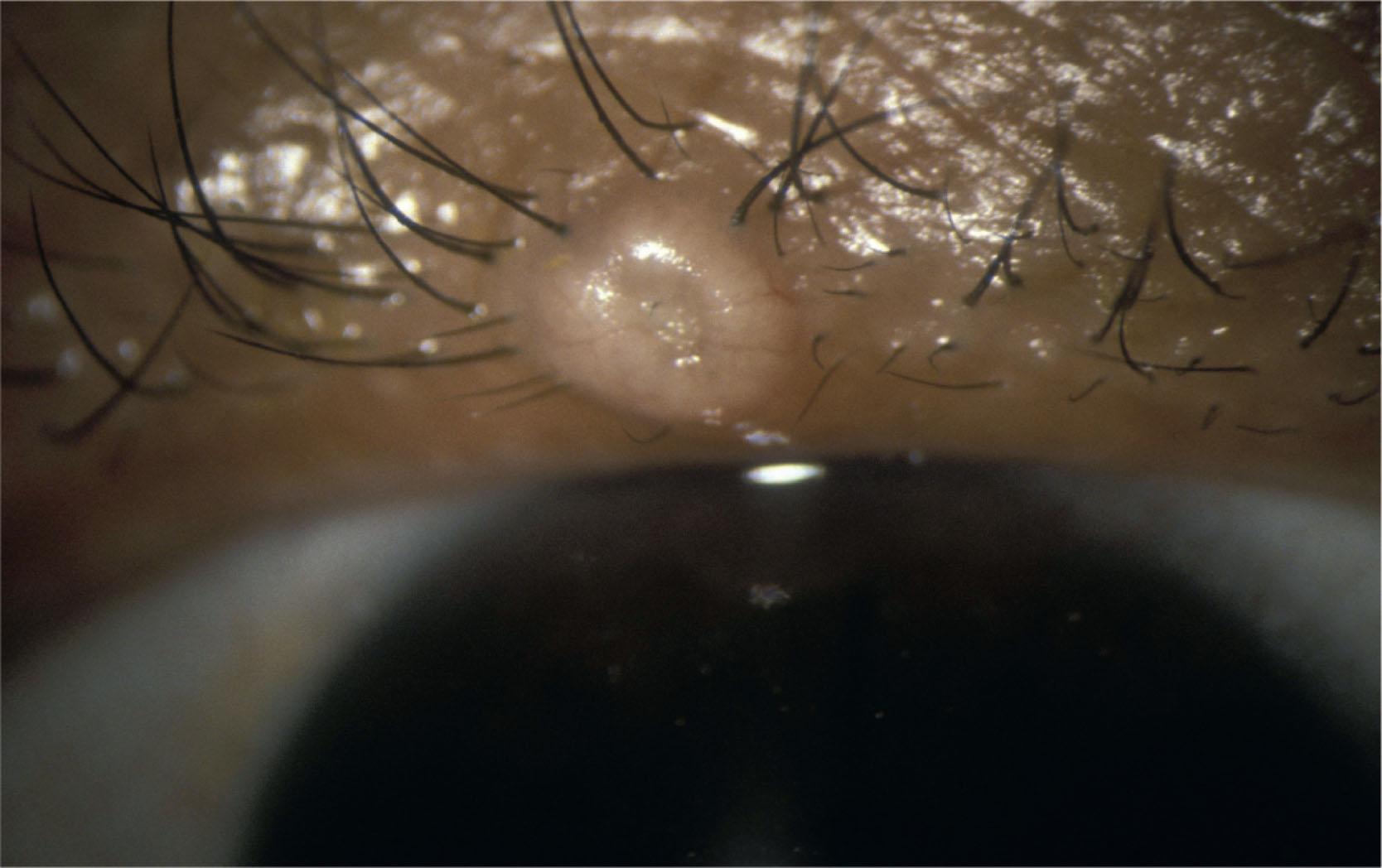
Become a Clinical Tree membership for Full access and enjoy Unlimited articles
If you are a member. Log in here